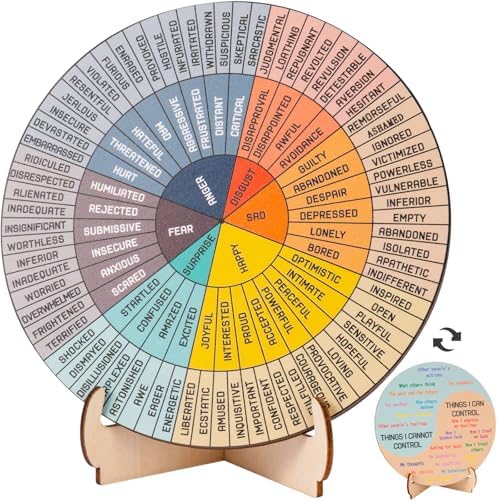· Ashley Anderson · men's health · 6 min read
Where Did My Peace of Mind Go?
This article contains affiliate links, which means that if you click on one of the product links and make a purchase, we may receive a small commission at no additional cost to you. We only recommend products and services that we believe in and think will add value to our readers.
Discover how to regain your peace of mind with practical tips and strategies. Learn to identify, process, and manage emotions effectively.

In the hustle and bustle of modern life, it’s easy to lose sight of what truly matters. For men over 40, the pressures of work, family, and health can often feel overwhelming. But what happens when these stressors start to chip away at your peace of mind? Where does it go, and how can you get it back? In this article, we’ll explore the root causes of lost peace of mind, share personal experiences, and introduce a powerful tool that can help you reclaim your inner tranquility.
The Silent Thief: Stress and Anxiety
Stress and anxiety are like silent thieves, creeping into our lives and stealing our peace of mind. They can manifest in various ways—from constant worry to physical symptoms like headaches and insomnia. For many men, the pressure to provide for their families and maintain a successful career can be a significant source of stress. Add to that the natural aging process, and it’s no wonder many men over 40 find themselves asking, “Where did my peace of mind go?”
Personal Experience: The Struggle is Real
I remember a time when the weight of my responsibilities felt like a boulder on my chest. I was constantly worried about work deadlines, my kids’ future, and even my own health. It seemed like every decision I made was fraught with anxiety. My peace of mind had vanished, and I didn’t know how to get it back.
Introducing the Feelings Wheel Therapy Office Desk Decor
Enter the Feelings Wheel Therapy Office Desk Decor, a powerful tool designed to help you navigate your emotions and reclaim your peace of mind. This double-sided mental health office emotions chart is not just a decorative piece; it’s a therapeutic aid that can guide you through your emotional journey.

How to Use the Feelings Wheel
- Identify Your Emotions: The first step is to recognize what you’re feeling. The Feelings Wheel helps you pinpoint your emotions, whether they’re positive or negative.
- Understand the Root Cause: Once you’ve identified your emotions, try to understand what’s causing them. Is it work stress? Family issues? Health concerns?
- Address the Issue: With a clear understanding of your emotions and their root cause, you can start to address the issue. This might involve problem-solving, seeking support, or simply acknowledging your feelings.
Personal Experience: The Turning Point
Using the Feelings Wheel was a turning point for me. It helped me realize that my anxiety wasn’t just about work or family—it was also about my own fears and insecurities. Once I understood that, I could start to address those issues head-on and reclaim my peace of mind.
Where Can You Buy the Feelings Wheel?
You can purchase the Feelings Wheel Therapy Office Desk Decor on Amazon. It’s an investment in your mental health that you won’t regret.
Pros and Cons of the Feelings Wheel
Pros:
- Helps identify and understand emotions
- Promotes self-awareness and emotional intelligence
- Can be used in both personal and professional settings
Cons:
- May not be suitable for those with severe emotional distress
- Requires self-reflection and honesty
- Not a replacement for professional therapy
Who Benefits from the Feelings Wheel?
The Feelings Wheel is beneficial for anyone looking to improve their emotional intelligence and mental well-being. It’s particularly useful for:
- Men over 40 dealing with stress and anxiety
- Professionals seeking to enhance their emotional awareness
- Individuals in therapy or counseling who want a tool for self-reflection
Scenarios Where the Feelings Wheel Shines
- Workplace Stress: Use the Feelings Wheel to identify and address work-related stressors.
- Relationship Issues: Pinpoint emotions related to family or romantic relationships and work towards resolution.
- Health Concerns: Address anxiety related to health issues by understanding and acknowledging your emotions.
Step-by-Step Instructions for Using the Feelings Wheel
- Set Aside Time: Find a quiet space where you won’t be disturbed.
- Reflect on Your Day: Think about the events of your day and how they made you feel.
- Use the Wheel: Refer to the Feelings Wheel to identify your emotions.
- Journal Your Thoughts: Write down what you’re feeling and why. This can help clarify your thoughts and emotions.
- Create an Action Plan: Based on your reflections, create a plan to address the root causes of your emotions.
Quick Takeaways
- Stress and anxiety can steal your peace of mind.
- The Feelings Wheel is a powerful tool for emotional awareness and self-reflection.
- Using the Feelings Wheel can help you identify, understand, and address your emotions.
- It’s beneficial for men over 40 dealing with stress and anxiety.
- The Feelings Wheel can be used in various scenarios to improve mental well-being.
Conclusion: Reclaim Your Peace of Mind
Losing your peace of mind can feel like a devastating blow, but it’s not an irreversible one. By using tools like the Feelings Wheel, you can begin to understand and address your emotions, reclaiming your inner tranquility. Men over 40, it’s time to take control of your mental health and find where your peace of mind went.
FAQs
Q: How does the Feelings Wheel help with stress and anxiety? A: The Feelings Wheel helps you identify and understand your emotions, which is the first step in managing stress and anxiety.
Q: Can the Feelings Wheel replace professional therapy? A: While the Feelings Wheel is a useful tool, it should not replace professional therapy. It can be used in conjunction with therapy to enhance emotional awareness.
Q: Who is the Feelings Wheel designed for? A: The Feelings Wheel is designed for anyone looking to improve their emotional intelligence and mental well-being, particularly men over 40 dealing with stress and anxiety.
Q: How often should I use the Feelings Wheel? A: The frequency of use depends on your needs. Some people find it helpful to use the Feelings Wheel daily, while others may use it less frequently.
Q: What if I’m not good at identifying my emotions? A: The Feelings Wheel is designed to help you identify your emotions. With practice, you’ll become more adept at recognizing and understanding your feelings.
If you’re a man over 40 struggling with stress and anxiety, you might be asking yourself, “Where did my peace of mind go?” The good news is that it’s not gone forever—it’s just waiting to be reclaimed. Share this article with other men who might be going through the same struggle, and let’s start a conversation about mental health and well-being. Together, we can find where our peace of mind went and bring it back.
Encourage Social Shares: If this article resonated with you, please share it with others who might benefit from the insights and tools discussed. Let’s spread awareness about mental health and support each other in our journey to reclaim our peace of mind.




